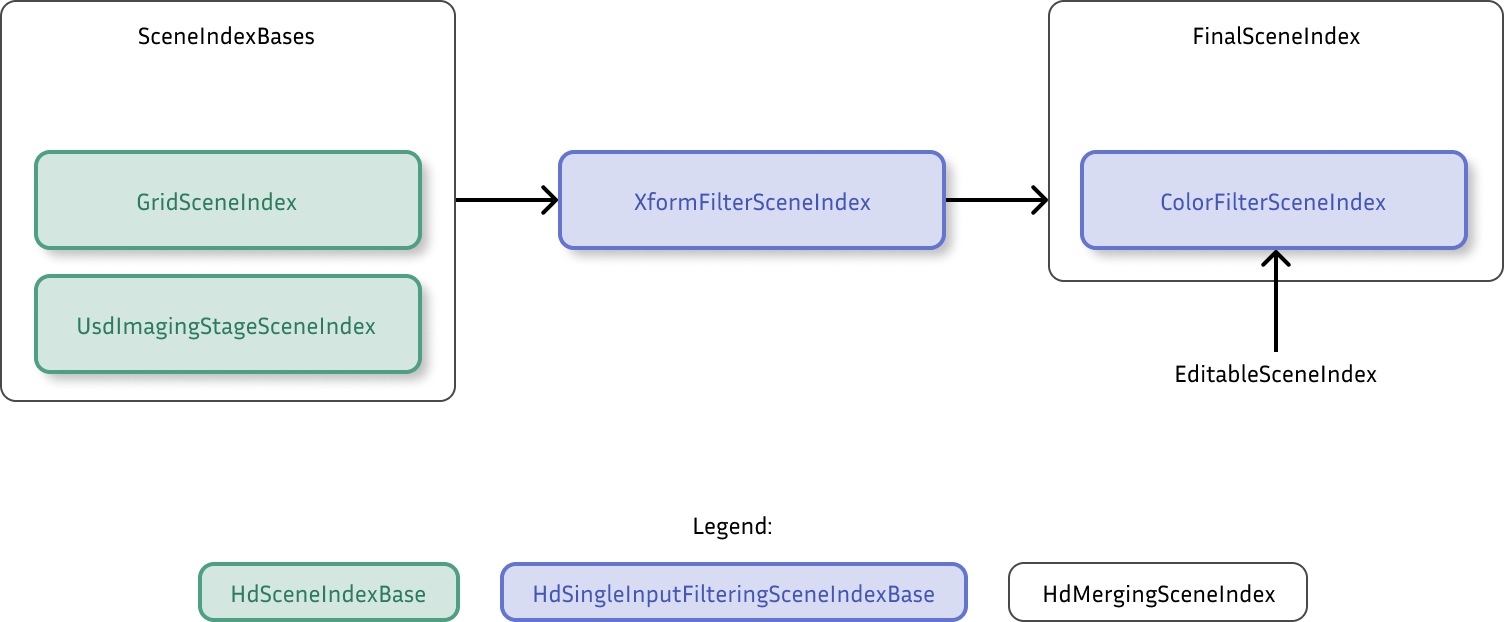ImGui Hydra Editor is a Hydra editor written in c++ with the ImGui and OpenUSD frameworks.
This project acts as a playground for USD, and most particularly Hydra 2.0. Therefore, the structure of the application remains simple and contains out of the box examples.
To build ImGui Hydra Editor, see BUILDING.md instructions.
ImGui Hydra Editor is a tool that processes data using the Hydra 2.0 Framework. Every view from the tool has access to read, insert and author the current state of Hydra data.
From the Usd Session Layer view, the user can type a stage from scratch, add some predefined USD Prim (camera, cube, sphere, ...) or load a USD file and author it. The Usd Session Layer then converts the USD Prims to Hydra Prims and inserts them to Hydra data.
The Outliner view browses all Hydra prims from Hydra data and displays them in a tree view.
The viewport view authors the transforms (translate, rotate, scale) of Hydra Prims. It also creates and inserts a grid to Hydra data.
The Editor view allows the user to author the display color of the selected Hydra Prim. The view also displays all the Hydra attributes from the selection.
The Engine consumes Hydra data with all modifications from the views and generates an image from it.
ImGui Hydra Editor implements main concepts of Hydra 2.0 framework out of the box, such as:
- inserting data using HdSceneIndexBase and UsdImagingStageSceneIndex.
- authoring data via HdSingleInputFilteringSceneIndexBase
- merging multiple data source using HdMergingSceneIndex
The views in ImGui Hydra Editor make use of those various types of scene index in order to create the final data to feed to Hydra (Hydra data).
HdSceneIndexBase is used to insert data to Hydra data.
Examples are:
- UsdImagingStageSceneIndex: used by Usd Session Layer to convert USD data to Hydra data.
- GridSceneIndex: used by Viewport to create and insert a grid to Hydra data.
HdSingleInputFilteringSceneIndexBase is used to filter Hydra data in order to author the Hydra Prim states.
Examples are:
- XformFilterSceneIndex: used by Viewport to author the xform of Hydra Prims.
- ColorFilterSceneIndex: used by Editor to author the display color of Hydra Prims.
HdMergingSceneIndex is used to merge multiple scene indices together.
Examples are:
- SceneIndexBases: merge multiple inputs (USD prim & grid) to a single output.
- FinalSceneIndex: always contains the scene index with the latest changes.
In order for the render engine to be more flexible, the render is performed using HdRenderIndex, HdEngine and HdxTaskController. See the code for more information.
There is two ways to navigate within the viewport: using the guizmo cube or the mouse and keyboard.
Keep pressing on the guizmo cube and move the mouse to rotate around the focus point. Click on faces/edges/vertices from the cube to change the active camera position accordingly.
Note: guizmo cube navigation is not working properly with z up axis (see Limitation section).
Here are the shortcuts to navigate using the mouse and the keyboard:
- LMB + Alt: Rotate
- LMB + Shift: Pan
- RMB + Alt or Scroll wheel: Zoom
- F: Focus on selection
- W: Local translate
- E: Local rotate
- R: Local scale
Every renderer that implements a hydra render delegate can be used in this project to extends the renderer list.
Here is an example of 4 different renderers: Storm, Embree, Cycle and Arnold.
Once the custom render delegates are build, don't forget to set the PXR_PLUGINPATH_NAME environment variable before launching the application to make use of them.
Explore the menu bars of the application and viewports, you may find useful fonctionalities such as:
- Create new USD objects in the scenes (Camera, Cube, ...)
- Create new views in the main window
- Switch the active camera to the viewport
- Show/Hide the grid
- Show/Hide ambient light, dome light
- Set global/local transform tool
- ...
There is currently some limitations
- ImGuizmo bug: glitchy navigation by using the gizmo cube when the stage up axis is Z (Z up axis is hardcoded in ImGuizmo)
- ImGuizmo bug: guizmo cube not working if multiple viewports and selection is empty
- Instances editing (e.g. translate) is not currently supported
- Single selection
- No Animation
- Simple events (no signal/slot implementation)
- Instanceable not visible in Outliner
- Instanceable cannot be selected (if so selection will switch to parent)
- No Undo
- Grid is on a separate layer at the back
- Does not keep multiple instances of same view when relaunched




